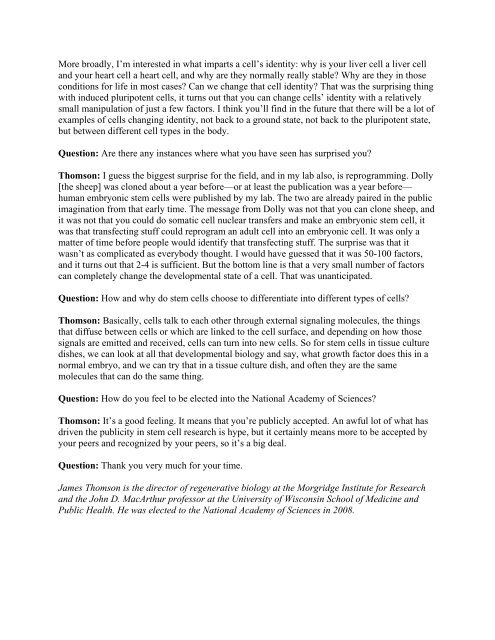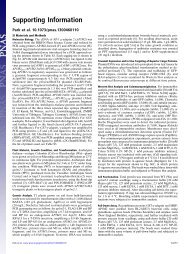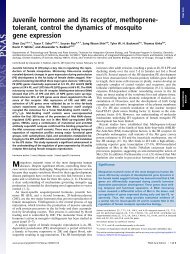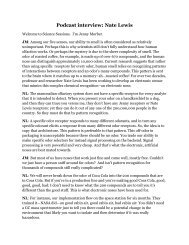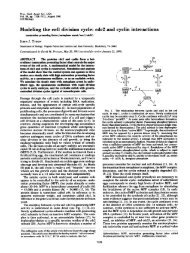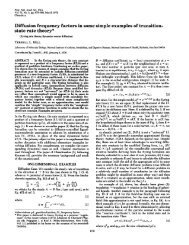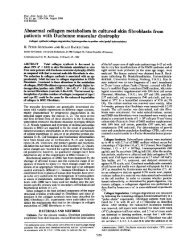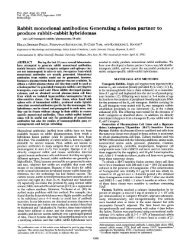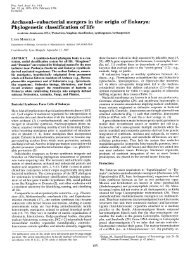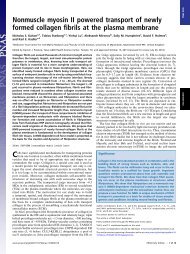Podcast Interview: Jennifer Lippincott-Schwartz - Proceedings of the ...
Podcast Interview: Jennifer Lippincott-Schwartz - Proceedings of the ...
Podcast Interview: Jennifer Lippincott-Schwartz - Proceedings of the ...
You also want an ePaper? Increase the reach of your titles
YUMPU automatically turns print PDFs into web optimized ePapers that Google loves.
More broadly, I’m interested in what imparts a cell’s identity: why is your liver cell a liver cell<br />
and your heart cell a heart cell, and why are <strong>the</strong>y normally really stable? Why are <strong>the</strong>y in those<br />
conditions for life in most cases? Can we change that cell identity? That was <strong>the</strong> surprising thing<br />
with induced pluripotent cells, it turns out that you can change cells’ identity with a relatively<br />
small manipulation <strong>of</strong> just a few factors. I think you’ll find in <strong>the</strong> future that <strong>the</strong>re will be a lot <strong>of</strong><br />
examples <strong>of</strong> cells changing identity, not back to a ground state, not back to <strong>the</strong> pluripotent state,<br />
but between different cell types in <strong>the</strong> body.<br />
Question: Are <strong>the</strong>re any instances where what you have seen has surprised you?<br />
Thomson: I guess <strong>the</strong> biggest surprise for <strong>the</strong> field, and in my lab also, is reprogramming. Dolly<br />
[<strong>the</strong> sheep] was cloned about a year before—or at least <strong>the</strong> publication was a year before—<br />
human embryonic stem cells were published by my lab. The two are already paired in <strong>the</strong> public<br />
imagination from that early time. The message from Dolly was not that you can clone sheep, and<br />
it was not that you could do somatic cell nuclear transfers and make an embryonic stem cell, it<br />
was that transfecting stuff could reprogram an adult cell into an embryonic cell. It was only a<br />
matter <strong>of</strong> time before people would identify that transfecting stuff. The surprise was that it<br />
wasn’t as complicated as everybody thought. I would have guessed that it was 50-100 factors,<br />
and it turns out that 2-4 is sufficient. But <strong>the</strong> bottom line is that a very small number <strong>of</strong> factors<br />
can completely change <strong>the</strong> developmental state <strong>of</strong> a cell. That was unanticipated.<br />
Question: How and why do stem cells choose to differentiate into different types <strong>of</strong> cells?<br />
Thomson: Basically, cells talk to each o<strong>the</strong>r through external signaling molecules, <strong>the</strong> things<br />
that diffuse between cells or which are linked to <strong>the</strong> cell surface, and depending on how those<br />
signals are emitted and received, cells can turn into new cells. So for stem cells in tissue culture<br />
dishes, we can look at all that developmental biology and say, what growth factor does this in a<br />
normal embryo, and we can try that in a tissue culture dish, and <strong>of</strong>ten <strong>the</strong>y are <strong>the</strong> same<br />
molecules that can do <strong>the</strong> same thing.<br />
Question: How do you feel to be elected into <strong>the</strong> National Academy <strong>of</strong> Sciences?<br />
Thomson: It’s a good feeling. It means that you’re publicly accepted. An awful lot <strong>of</strong> what has<br />
driven <strong>the</strong> publicity in stem cell research is hype, but it certainly means more to be accepted by<br />
your peers and recognized by your peers, so it’s a big deal.<br />
Question: Thank you very much for your time.<br />
James Thomson is <strong>the</strong> director <strong>of</strong> regenerative biology at <strong>the</strong> Morgridge Institute for Research<br />
and <strong>the</strong> John D. MacArthur pr<strong>of</strong>essor at <strong>the</strong> University <strong>of</strong> Wisconsin School <strong>of</strong> Medicine and<br />
Public Health. He was elected to <strong>the</strong> National Academy <strong>of</strong> Sciences in 2008.


